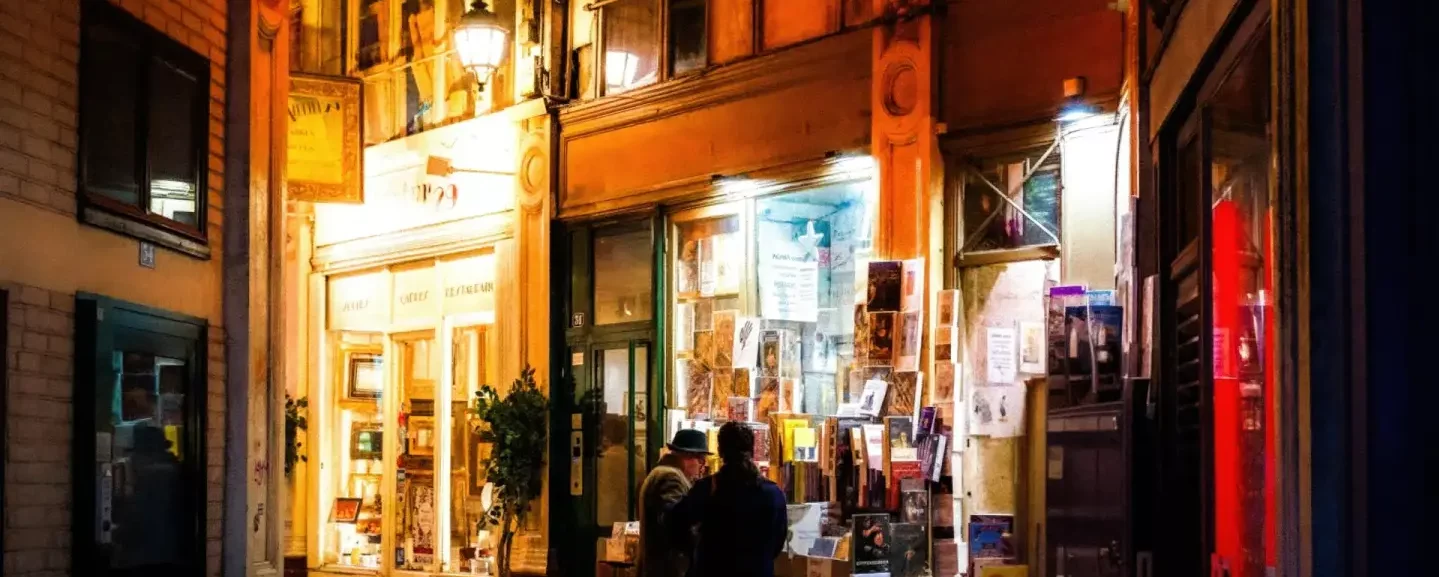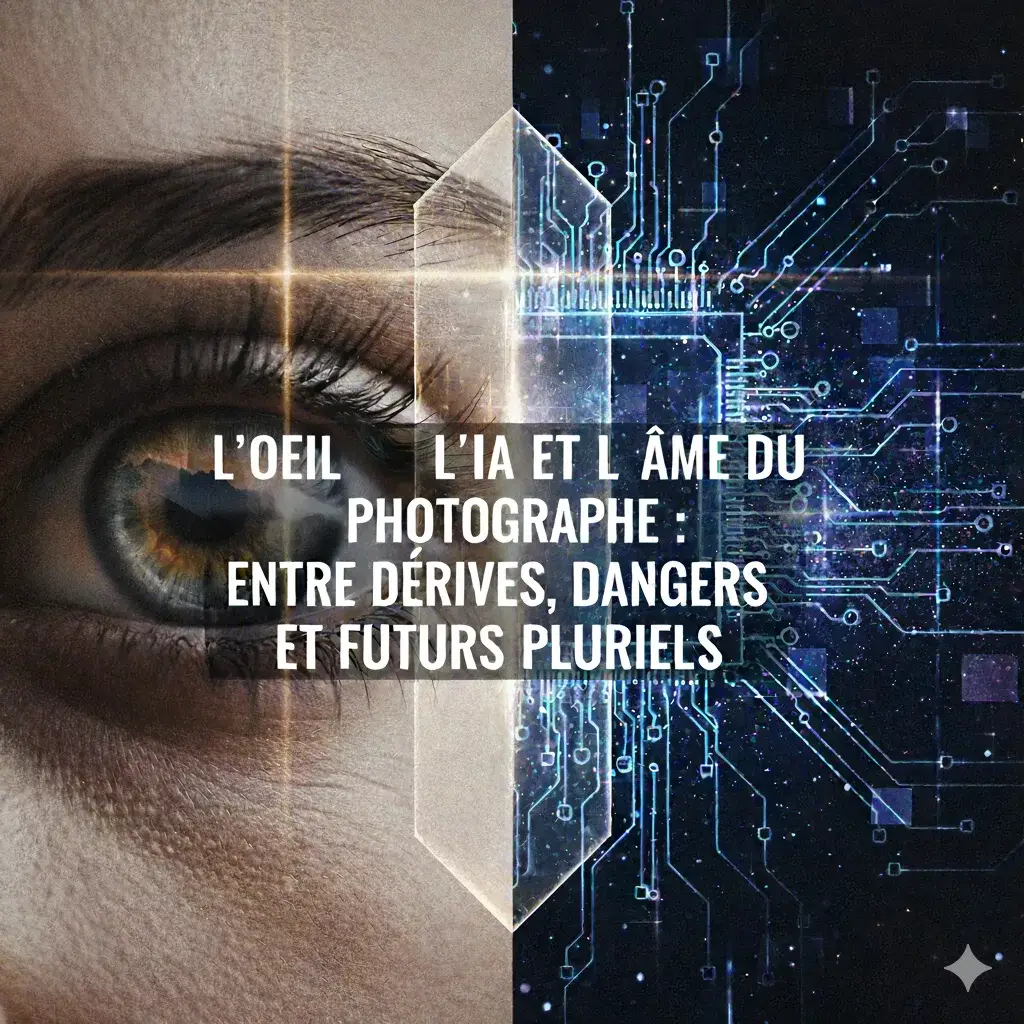The Eye of AI and the Soul of the Photographer: between Pitfalls, Dangers, and Plural Futures
Photography, an art intrinsically linked to the capture of reality, stands today at an existential crossroads. The rapid advent of generative artificial intelligence (AI) is shaking its foundations, promising infinite horizons while raising legitimate concerns. Far from a binary opposition, the coexistence of the human eye and the algorithm outlines a complex future, rich in unexpected complementarities and major ethical challenges.
The Genesis: when AI “Learns” Photography
AI did not appear ex nihilo in the world of images. Its beginnings in photography lie in image enhancement tools (denoising, sharpening), facial recognition, or retouching automation. But it was with generative AI (Stable Diffusion, Midjourney, DALL-E) that the paradigm shifted. Trained on billions of existing images, these AIs no longer “retouch”: they “create” from scratch, based on simple textual descriptions (prompts). Absolutely! This is a fascinating, complex subject at the heart of current artistic and technological developments. Let us prepare to delve into the depths of the relationship between photography and AI, with all its nuances.
Strengths and Complementarities: AI as a Revolutionary Tool
Rather than an adversary, AI can be perceived as an arsenal of augmented tools for the photographer.
- The Augmented Assistant:
- Accelerated Post-production: Clipping, color correction, removal of unwanted elements (removing a passerby, glare suppression) in a few clicks. Software like Lightroom or Photoshop already integrate impressive AI functions.
- Image Enhancement: Upscaling (enlargement without loss of quality), intelligent denoising, restoration of old photos with unprecedented precision.
- Composition and Framing: AIs can suggest compositions based on the analysis of millions of aesthetic photos.
- The Creative Explorer:
- Visual Prototyping: A photographer can use generative AI to quickly visualize concepts for scenes, lighting, and sets before an expensive shoot. It is a dynamic and virtually unlimited mood board.
- Extension of Imagination: Creation of impossible backgrounds, fantastic creatures, surreal atmospheres for daring photographic montages.
- Overcoming “Writer’s Block”: AI can generate visual ideas to stimulate human creativity.
- Accessibility and Democratization:
- Sophisticated tools become accessible to all, reducing the technical barrier and allowing a greater number of people to explore visual creation.
Weaknesses and Limitations of Generative AI
Despite its prowess, generative AI is far from perfect, especially when compared to photography in the traditional sense.
- Absence of Lived Experience: AI has no eye, no hand, no heart. It has not waited for hours for the perfect light, has not felt the cold or the joy of the moment. It does not “live” the scene. Photography is the art of capturing a
real moment . AI creates an imaginary snapshot. - Lack of Deep Intention and Context: An AI-generated image has no intrinsic story beyond its prompt. The photographer imbues it with meaning, intention, a commentary on the world.
- The Visual “Uncanny Valley”: Despite progress, AIs can still produce aberrations (six-fingered hands, strange artifacts, inconsistent spatial logic) that betray their artificial nature.
- Dependence on Training Data: AI does not truly create; it combines and transforms what it has “seen”. Its “creativity” is a statistical extrapolation, not an intuition.
- Difficulty in Grasping Nuances: Subtle emotion, the fragility of a gaze, the imperceptible tension of an atmosphere are still difficult for AI alone to authentically reproduce.
Pitfalls and Dangers: the Shadows on the Horizon
This is where vigilance is imperative. The negative impact of AI on photography is a significant reality.
- Crisis of Authenticity and “Deepfakes”:
- The ability to generate photorealistic images of anything (or anyone) jeopardizes the very notion of “photographic proof”.
- “Deepfakes” (manipulated videos or images of real people) are a threat to information, politics, and privacy.
- Pitfall: Widespread loss of trust in images.
- Ethical and Copyright Issues:
- AIs are trained on existing works, often without the consent or remuneration of the creators. Where does the line lie between “inspiration” and “plagiarism”?
- Who is the author of an AI-generated image? The programmer? The prompt user? The AI itself? The question is far from being legally settled.
- Pitfall: Impoverishment of original creators and dilution of the notion of intellectual property.
- Loss of Value of Human Work:
- Companies may be tempted to replace photographers or illustrators with generative AIs, which are cheaper and faster.
- Pitfall: Market race to the bottom, devaluation of certain technical skills (retouching, basic composition).
- Aesthetic Homogenization:
- If everyone uses the same AIs with similar prompts, is there not a risk of a dominant, predictable, and stereotypical aesthetic emerging?
- Pitfall: Less diversity, less aesthetic innovation outside the beaten path of AI.
Coexistence and Future: Finding the Path to Balance
The solution is neither total rejection nor blind adoption. The future of photography and AI lies in intelligent and ethical coexistence.
- AI as a Partner, Not a Substitute:
- The photographer uses AI to automate repetitive tasks (sorting, basic retouching) or to explore creative avenues (prototyping).
- The photographer retains control over the vision, artistic direction, and capture of the real moment. AI becomes a technological “brush” in the artist’s hand.
- Example: A fashion photographer uses AI to create virtual backgrounds or impossible textures for their real models.
- Valuing the Human and the Authentic:
- Photographers must more than ever highlight their uniqueness, their singular vision, their story behind the image.
- Real photographs, untouched by AI or with transparent AI usage, will gain value. The “proof of humanity” will become a marketing asset.
- Example: The rise of authentic “street photography” or photojournalism that certifies the absence of AI manipulation.
- Education and Transparency:
- The public must be educated about the nature of the images they consume. “AI mentions” or “AI-Generated” must become the norm.
- Platforms and creators must be transparent about the use of AI tools.
- Development of Ethics and Legal Frameworks:
- Legislation on copyright, data protection, and “photographic proof” must evolve to regulate AI.
- Industry standards (e.g., invisible digital “watermarks” for AI-generated images) could emerge.
- AI in Service of Preservation:
- AI can help restore damaged photographic archives, analyze enormous image corpuses for historical research, or even identify counterfeit works.
Conclusion: the Future is Hybrid
AI does not “kill” photography; it transforms it. It forces photographers to redefine their art, to focus on what makes humans irreplaceable: emotion, intuition, lived experience, the singularity of vision. The future will likely be hybrid: works where the capture of reality through the lens will be augmented, sublimated, or even reinvented by the computational power of AI.
The dangers are real, but the opportunities are just as significant for those who can master this powerful tool with ethics, discernment, and an intact artistic vision. True photography, after all, has never been just a technique, but a window open to the soul.
This post is also available in:
French

